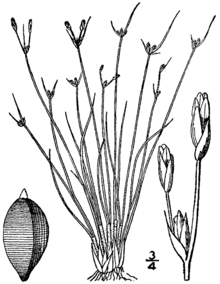Bulbostylis capillaris
| threadleaf beakseed densetuft hairsedge | |
|---|---|
 | |
| 1913 illustration[1] | |
| Scientific classification | |
| Kingdom: | Plantae |
| (unranked): | Angiosperms |
| (unranked): | Monocots |
| (unranked): | Commelinids |
| Order: | Poales |
| Family: | Cyperaceae |
| Genus: | Bulbostylis |
| Species: | B. capillaris |
| Binomial name | |
| Bulbostylis capillaris (L.) Kunth ex C.B.Clarke | |
| Synonyms[2] | |
| |
Bulbostylis capillaris is a species of sedge known by the common names densetuft hairsedge and threadleaf beakseed. It is native to much of North America, South America and the West Indies from Canada to Bolivia.[2][3][4][5][6][7][8][9][10][11][12]
Bulbostylis capillaris grows in many types of habitat, generally in moist areas such as streamside meadows. It is an annual herb which is somewhat variable in appearance but generally takes the form of a small, upright tuft of green herbage growing close to the ground. There are several stems surrounded by thready, thin leaves. The inflorescence occurs at the tip of the stem and is composed of tiny spikelets which are green washed with rusty red. The fruit is about a millimeter long.
References
- ↑ Britton, N.L., and A. Brown. 1913. An illustrated flora of the northern United States, Canada and the British Possessions. 3 vols. Charles Scribner's Sons, New York. Vol. 1: 319.
- 1 2 Kew World Checklist of Selected Plant Families
- ↑ Flora of North America, Vol. 23 Page 136, Bulbostylis capillaris (Linnaeus) C. B. Clarke in J. D. Hooker, Fl. Brit. India. 6: 652. 1893.
- ↑ Biota of North America Program, 2013 county distribution map
- ↑ Brako, L. & J. L. Zarucchi. (eds.) 1993. Catalogue of the Flowering Plants and Gymnosperms of Peru. Monographs in systematic botany from the Missouri Botanical Garden 45: i–xl, 1–1286.
- ↑ Davidse, G., M. Sousa Sánchez & A.O. Chater. 1994. Alismataceae a Cyperaceae. 6: i–xvi, 1–543. In G. Davidse, M. Sousa Sánchez & A.O. Chater (eds.) Flora Mesoamericana, Universidad Nacional Autónoma de México, México, D.F.
- ↑ García-Mendoza, A. J. & J. Meave del Castillo. 2011. Diversidad Florística de Oaxaca: de Musgos a Angispermas 1–351. Universidad Nacional Autónoma de México, Ciudad Universitaria
- ↑ Kral, R. 1971. A treatment of Abildgaardia, Bulbostylis and Fimbristylis (Cyperaceae) for North America. Sida 4(2): 57–227
- ↑ Funk, V. A., P. E. Berry, S. Alexander, T. H. Hollowell & C. L. Kelloff. 2007. Checklist of the Plants of the Guiana Shield (Venezuela: Amazonas, Bolivar, Delta Amacuro; Guyana, Surinam, French Guiana). Contributions from the United States National Herbarium 55: 1–584
- ↑ Jørgensen, P. M. & C. Ulloa Ulloa. 1994. Seed plants of the high Andes of Ecuador–A checklist. AAU Reports 34: 1–443
- ↑ Ragonese, A. E. 1941. La vegetacion de la Provincia de Santa Fe (R. A.). Darwiniana 5: 369–416.
- ↑ Killeen, T. J. & T. S. Schulenberg. 1998. A biological assessment of Parque Nacional Noel Kempff Mercado, Bolivia. Rapid Assessment Program Working Papers 10: 1–372.
External links
This article is issued from Wikipedia - version of the 7/13/2014. The text is available under the Creative Commons Attribution/Share Alike but additional terms may apply for the media files.